


It’s no secret that a free guide or ebook can help you tap into the power of online marketing and put your email list building efforts on steroids.
More than that, a guide can help you build authority, gain respect and trust, position you as an expert and thought-leader in your niche, kick-start the nurturing process, create new customer relationships, segment your market, gather audience insights, and give prospects a preview of your brand, products, and services. Although there’s no monetary exchange involved, giving potential consumers a freebie in exchange for their email address is still an incredibly valuable transaction.
BUT a lead magnet can also make or break your sales funnel success.
Look, lead magnets aren’t some newfangled idea. They’ve have been a necessary tool in a marketer’s arsenal for decades. Just check out this highly successful 70’s print ad for a free book from Ford Motor Company:
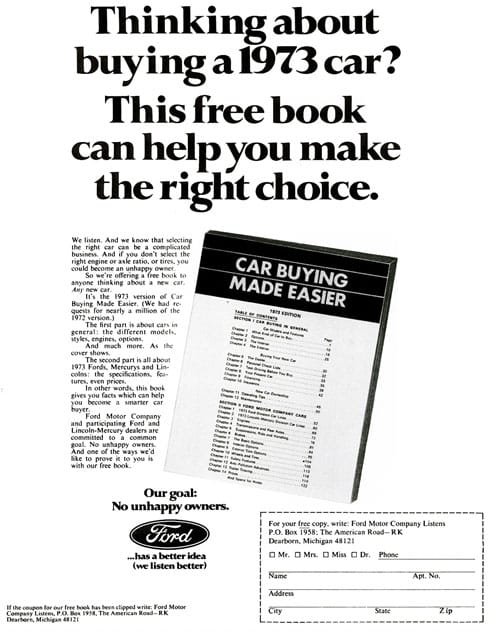
In this second ad, Ford claims they received requests for nearly a million copies, proving their lead magnet was very much needed.
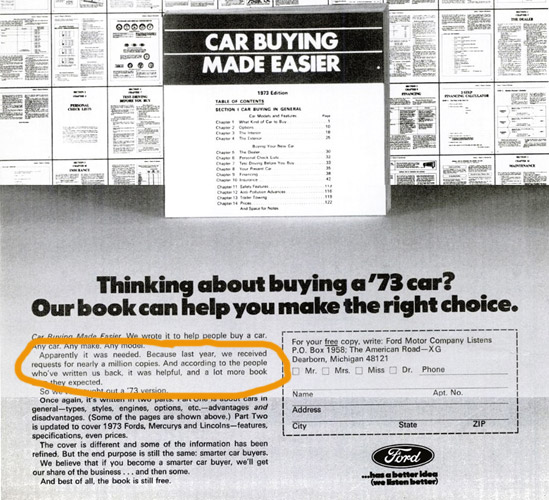
So if we’ve been using lead magnets for decades why don’t businesses have this down yet? Why are so many lead magnets complete failures?
Here’s the thing: the lure of ‘free’ is extremely powerful and persuasive, which is why high-value lead magnets like guides work so well as part of an inbound marketing strategy. However, many bomb because business owners focus on attracting subscribers rather than lifelong customers.
But it’s not the volume of an email list that counts. It’s the quality.
When the highest earning lists are often those derived from hyper-targeted lead magnets, you don’t want yours to be attractive to everyone—just your ideal buyer. After all, why would you want to give something away to someone who is never likely to engage with you or your business beyond your initial lead magnet offer?
Answer: you don’t.
So, with lead quality being super important, how do you ensure your guide hits the spot and appeals to the right people?
Well, let’s take a look at the qualities of high-converting guides.
They are ultra-specific.
The most effective guides are relevant to the needs and wants of the business’s ideal buyer persona. They are not vague but rather designed to appeal to a very specific target audience, solving a specific problem with a specific solution. This ensures you only generate qualified leads (i.e. people who will actually download and consume your freebie).
They are packed with tremendous value.
If your lead magnet is all sizzle and no steak, it’s sure to be a dud. A good guide provides substance. It’s useful, it delivers on your promise, and it keeps your prospect’s attention. It doesn’t have to be long or complex, but it must be worthy of a read if you want to make an impact.
They are instantly accessible.
Few things are more frustrating than opting in for a lead magnet only to wait long periods before receiving it. In today’s world where instant gratification has become the order of the day, consumers want access to the solution you’re offering NOW. Making them wait can put a damper on their excitement and make them forget they even signed up for your offer.
They are highly focused and actionable.
High-converting guides don’t give away the farm, but they are actionable. They speak to a single pain point or idea, allowing readers to take some sort of positive action towards a specific goal while leaving them wanting more.
They lay the foundation for a long-term customer relationship.
Lead magnets shouldn’t just inform but also pre-frame your prospect for future business. By creating a lead magnet with customer retention in mind, you essentially set yourself up as the person prospects look to for solutions to additional problems related to the one you just solved. Their initial satisfaction in your lead magnet builds trust and gets them to agree to move into the next stage of your sales funnel.
They are related to specific products and services.
The paid offering at the bottom of the sales funnel must be directly related to the lead magnet at the top of a sales funnel. Many business owners forget their ultimate goal, which results in poor targeting and unqualified leads. Creating a single lead magnet for a multitude of products and services might sound efficient, but more often than not it’s also ineffective.
They are easy to consume.
Consumers have short attention spans and are already bombarded with information, which is why the best guides are quick and easy to consume. Rather than causing a roadblock in the sales process, they allow prospects to solve an urgent problem that demands an immediate response.
They are well designed.
A lead magnet is a representation of a business’s brand. It might be free, but it’s also the first contact a potential customer has with a business. A well designed and branded guide not only grabs attention and creates a good first impression, but it also sets the tone for the kind of value people can expect to receive from you.
Fortunately, creating an awesome lead magnet geared towards creating long-term customers isn’t as difficult as it looks. If you’re not sure what topic to write about, how to design your document, or what you should do with it once you have a final version ready for consumers, stick around and follow these steps to create your own. I’ll even show you how the creation of my guide during each step of the process.
The goal here is to develop lead magnet concepts that will make visitors super excited about taking you up on your offer while simultaneously helping you achieve your subscriber and sales goal. That means getting clear on who your target buyer is and what you hope to achieve.
Understanding what you want
Prior to constructing your lead magnet, you need to define its purpose. What’s the #1 thing you want your guide to do? What action should people take once they’ve consumed your content? Sure, you want to increase your subscriber numbers and revenue, but what role does your lead magnet play in moving people in the right direction?
For example, a huge part of selling people on the services I offer is to provide value that demonstrates my expertise and make prospects understand how I can help them reach their goals with optimized Facebook Ad funnels. For my business, a free consultation is one of the best ways to do that. Therefore, the purpose of my guide is to increase the number of free consultation requests I receive so that I can ultimately increase sales. My lead magnet is specifically designed to support that purpose. If I closed with a ‘Buy Now’ call to action, I’d have a very low conversion rate because my leads aren’t ready for that yet.
Understanding what your customer wants
Much of what makes a good topic boils down to understanding your ideal buyer personas. You cannot simply target anyone with a pulse, so start by taking a deep dive into who your customers are and what they want. For example, are your target buyers looking for information or are they ready to buy? Can you use your lead magnet to show them something is possible that they may not have known was possible before now? Can you use your lead magnet to give them processes, tips, or ideas that save them time, money, or frustration?
To guide your brainstorming session, ask yourself the following questions:
Answering any one of these questions should spark some good lead magnet ideas. However, if you’re not sure what the answers are, be sure to add discovery emails to your email marketing, poll your audience on social media, conduct competitor research, survey existing customers, and use research tools like Google Analytics to identify your most popular content. The sky is the limit when it comes to developing highly targeted, value-packed, and engaging opt-ins your audience can’t resist.
In many cases, you’ll discover the best topics are created by turning a problem into a solution or value proposition statement.
Problem: I suffer from chronic neck pain.
Solution: 5 Exercises for Alleviating Chronic Neck Pain Instantly
Problem: I need to lose weight fast.
Solution: How to Lose 7 Pounds in 7 Days
Now let’s take a look at some examples from local businesses to inspire you:
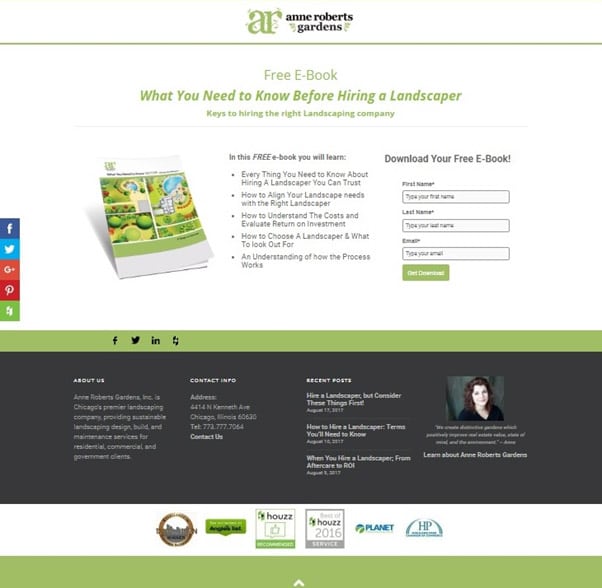
In this example, Anne Roberts Gardens—a Chicago-based residential and commercial landscaping business—uses a free download to appeal to anyone who may be experiencing anxiety over picking the right landscaper.

With their free guide, Underground Gym based in Red Bank, NJ, not only targets bodybuilders, but they get even more specific by focusing on their male audience only. Although they serve men and women of all ages, they understand the intricacies of each buyer persona.
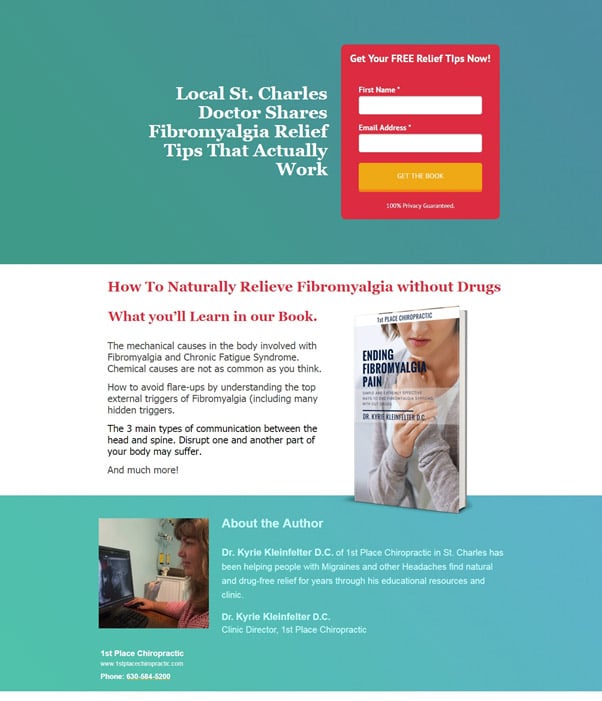
Even though 1st Place Chiropractic in St. Charles offers chiropractic treatment for a variety of ailments, their lead magnet is hyper-targeted to Fibromyalgia patients searching for drug-free pain relief.

Here, Brian R. Murphy Law Firm targets car accident victims in South Carolina. Notice how the landing page incorporates video, social proof badges, and a testimonial to establish credibility and trust with the firm’s ideal client.
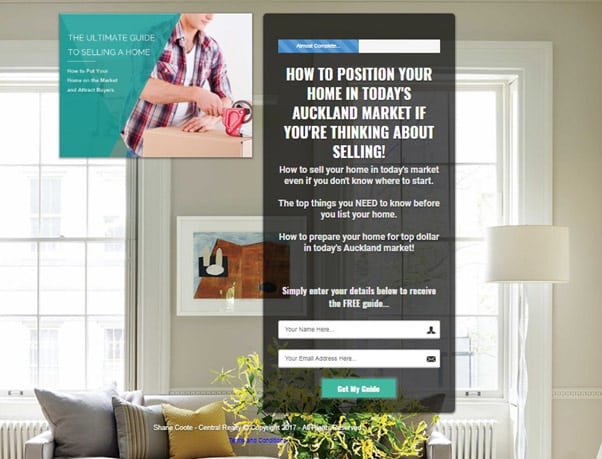
In his free guide, Auckland-based real estate agent Shane Coote teaches homeowners how to position their homes for selling in their current market.
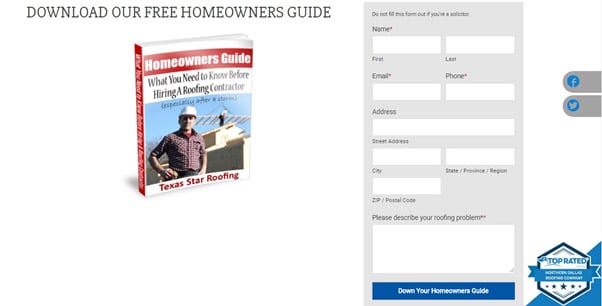
In our final example, Texas Star Roofing gives Texan homeowners the lowdown on hiring a roofing contractor after a storm. If they want to get more focused, they could target their guide to the areas in Texas they serve.
In producing my own free guide for Ignite Marketing, I wanted to save local business owners from the frustration of figuring out how to generate leads through one of the hottest paid marketing tools right now: Facebook Ads. My business is built on lead generation funnel development and Facebook Ad management. My audience wants a simple blueprint that cuts out the noise and allows them to implement a Facebook Ad funnel of their own without getting confused or having to search for other resources. And so, “A Step-By-Step Guide to Creating Paid Facebook Offers that Will Rapidly Grow Your Local Business” was born.
As we walk through the next few steps, I’ll show you exactly how I built the guide from scratch.
Whatever you do, make sure your free offering makes sense for both your target audience and your local business objectives. Brainstorm keyword-rich and attention-grabbing titles that are guaranteed to persuade people to give you their email address in exchange for a free download. Depending on your business and product or service offerings, you might even want to create several free guides and then set them up on your website to display based on your blog categories or the pages of your website a potential subscriber is visiting. This strategy enables you to target specific segments of your audience and deliver a more relevant offering.
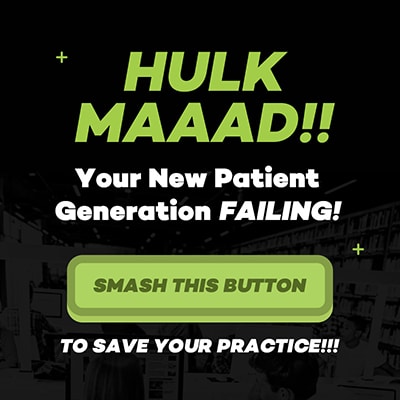 When it comes to preparing your guide and then converting it into various formats, you’re almost spoiled for choice. While word processing software includes programs like Microsoft Word, Open Office, and Google Docs, presentation software includes programs like PowerPoint, Google Slides, and Keynote. The best and easiest solution is often the one you’re familiar with and can navigate well. For my guide, I kept things cost-effective and simple by using Microsoft Word and then converting the document into a PDF file.
When it comes to preparing your guide and then converting it into various formats, you’re almost spoiled for choice. While word processing software includes programs like Microsoft Word, Open Office, and Google Docs, presentation software includes programs like PowerPoint, Google Slides, and Keynote. The best and easiest solution is often the one you’re familiar with and can navigate well. For my guide, I kept things cost-effective and simple by using Microsoft Word and then converting the document into a PDF file.
A few tips before we get started:
Okay, let’s prepare your guide.
Give your guide a relevant name.
The title for your guide is essentially your promise. In other words, the value or solution you’ll deliver to your targeted buyer persona. It’s important to get it right because it can drastically affect conversion rates.
So, what makes a great title?
An irresistible headline is catchy and specific. It focuses on outcomes and benefits. It’s clear first and clever second. Perhaps most importantly, it induces curiosity.
Consider my title for a minute:
What it is: a step-by-step guide
Who’s it for: local business owners
What’s it about: creating paid Facebook offers
What the benefit or outcome is: rapidly growing a local business
Your headline will either hook your prospect or result in a hard pass, so make sure you spend time turning the topic ideas you brainstormed in step one into titles that will attract the right audience.
Create an outline and write your content.
With your topic in mind, you need to figure out how you’ll present your thoughts. Are you sharing a process? What logical steps should your reader follow? Are you sharing tips? How many and in what order will you share them?
The easiest way to create your outline is to brain dump everything you want to share onto a sheet of paper. You should then organize your thoughts into high-level points and the sub points that fall under each one. Once you have logical sets, organize them into an outline that makes the most sense. Depending on your topic, you might need to refine your outline further. Be sure to remove anything that doesn’t directly relate to solving your customer’s problem and keep in mind that you want to your guide to be impactful but also easily consumable.
For my guide, I wanted to share both the process of setting up a lead generation funnel and the process of crafting and setting up a Facebook Offer Ad to promote the lead magnet positioned at the top of that funnel. The guide is longer than usual for a lead magnet, but it’s also image-rich so that readers can follow along with ease and feel comfortable developing and implementing their funnel on their own.
When you’re considering the length of your own lead magnet, focus on value rather than word count. In most cases, lead magnets are relatively short at about 1,000 to 3,000 words. However, your lead magnet should be designed to solve a problem your target market faces while baiting them to want to learn more because of the value you’ve already offered. That may result in a one pager or a lead magnet that’s several pages long.
Following along with my example, I know that a big problem many local business owners have with Facebook marketing lies in understanding the basic steps in setting up a simple Facebook Ad campaign and funnel without having to spend hundreds of dollars on a course. For DIYers, I wanted to provide a resource that lets them know exactly what they need to do to run Facebook Ads on their own without having to spend any money on that education. As a result, my outline looks like this:
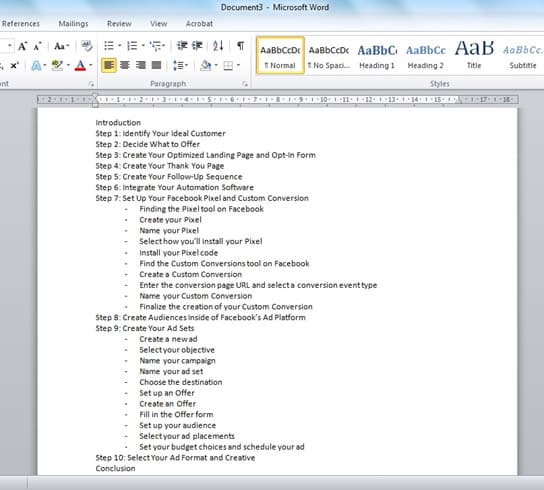
Using the outline, I then fleshed out each section to build the content into something worthwhile and interesting. Here’s the result:
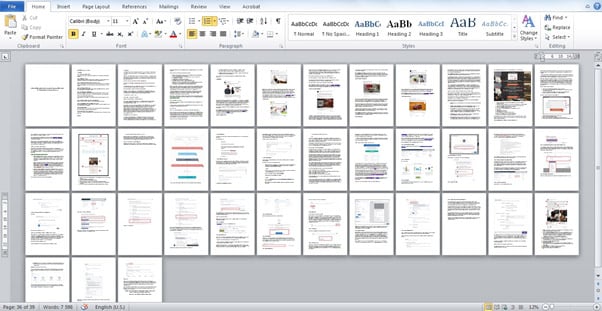
Now if you’re a local business owner who finds outlining and writing daunting, there are multiple ways to make this easy. Your first option is to hire a freelance writer or writing service to do the heavy lifting for you. Your second option is to record what you want to say and then transcribe it yourself or hire a transcription service. While you’ll likely need to clean up sentences later, you’ll at least have a rough draft with a conversational and natural feel.
Add your front matter.
Next, you’ll want to add your front matter. This could include a title page, a disclaimer, a copyright notification, a few testimonials, a short “about” section, a hyperlinked table of contents, and an introduction. What you choose to add will depend on personal preferences and what you want your guide to look like.
Since my guide is on the lengthier side, I included a table of contents that would later be hyperlinked during the design process. I also included a short description for each step so that readers would know what they’d learn as part of the funnel and ad creation process.

You can add front matter by placing your cursor at the beginning of your content and then pressing Ctrl+Enter to insert a page break. This will shift your content to the beginning of the next page.
Add your back matter.
When your readers reach the end of your lead magnet, you don’t want the interaction to end there. You want to motivate them to take specific actions that drive your objectives. This could include encouraging them to share your guide, check out your website, give you a call, book a free consultation, visit your business premises, and more.
Since the goal of my lead magnet is to boost free consultation requests with local business owners so that we can start a conversation about how my agency can help them achieve their lead generation and sales goals, I included a relevant and powerful call to action at the end of the guide.
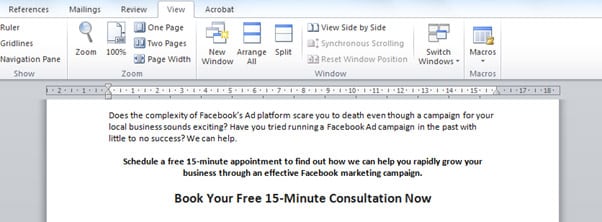
During the design process, this call to action will eventually be turned into a clickable button that links directly to my online booking software. Again, the call to action supports what you’re ultimately aiming to achieve for your local business. Therefore, you must treat it like the critical component it is by ensuring it’s clear and stands out from the rest of your content.
This is what mine looks like after it has gone through the design process:
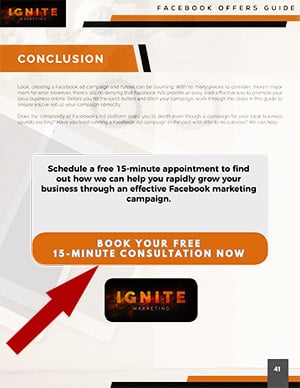
Next comes the fun part.
Work on your book’s design.
Although a polished and professional design won’t outperform killer content, it’ll certainly give leads the right impression and keep them on your list. The whole point of your lead magnet is to provide value, which can quickly get lost in the mix if your content’s organization and presentation are poor.
To ensure your document doesn’t look like an art store exploded on your page, be sure to keep things simple and appealing. You’ll also want to keep your branding in mind.
Here are some of the following design changes you can make:
An alternative to designing your document in Word is to use a free service like Canva. Canva is an awesome tool for non-designers who want to create stunning marketing assets that look like they’ve cost a fortune to produce. If you don’t have the time to play around with design tools and you have the funds to recruit a professional, consider hiring an experienced freelance designer to execute your vision for you.
I hired a professional and this is the result:
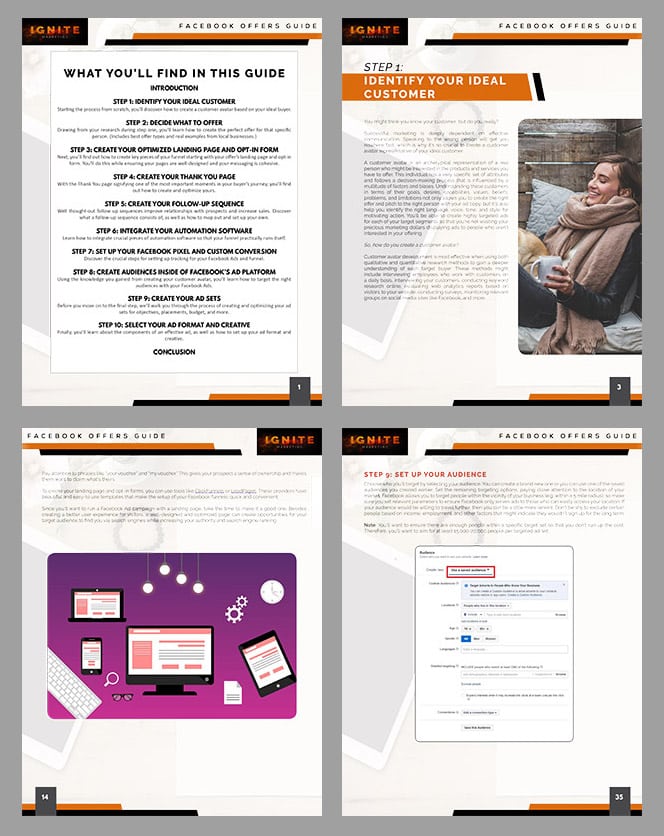
Once your guide looks the way you want it to, move onto the next step.
Turn your guide into a template.
Since you’ve put so much time and effort into producing an attractive guide, save yourself some frustration in the future by saving your Word document as a template. To do this, click “File” and then “Save As.” Enter a relevant file name and then select “Word Template” from the “Save as type” dropdown menu. Word will store your template under “My Templates,” which you can access by clicking “New” under the “File” menu.

Whether you like it or not, visitors to your landing page will judge your guide by its cover. It’s human nature, which is why you’ll need to create a design prospects simply can’t resist.
Check out the one created for my guide:
Canva makes cover design easy by offering some amazing templates. You can also use design tools like InDesign or hire a professional to get your cover looking great. However, it’s crucial to understand the key functions of a captivating cover and its role in your market positioning before you begin your design.
Your free lead magnet will set the tone for what prospects can expect from you and your business in the future. If you’re unable to sway them to part with their email address now, they’ll be unlikely to hand over their hard-earned cash when you try to sell them on your products or services.
With that said, an effective cover design should pop on the page and draw your prospect’s eye. It should be visually appealing and set the mood and tone for the content inside it. It should hint at the quality of writing and build on your business brand. Ultimately, it should persuasively say, “Download me!”
If you’re unsure what that looks like for a lead magnet in your industry, research the designs of your competitors. Take a look through Kindle ebooks to see what captures your eye. There’s plenty of inspiration online—all you need to do is look for it.
Word has a built-in PDF converter, so you don’t need tools like Adobe Acrobat. Simply click the “File” tab and select “Save as Adobe PDF.” You can then give your lead magnet file a name and decide where you want to store the document.
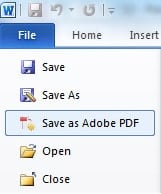
If you’ve used Canva to create your design, you’ll be able to choose PDF from Canva’s saving options. If you’ve used another program, you’ll find there are several free PDF converters available online. Just be careful which one you use as some tools will strip your guide of hyperlinks.
Once you’ve converted your guide, make sure everything looks the way you intended. If you need to make change, simply navigate your way back to the original document, make your alterations, and then save the guide as a PDF again. Ideally, you’ll also check what your guide looks like on different devices to ensure all images render correctly.
Now that your brand new digital asset is ready for your ideal buyer to devour, you’ll need to determine how you’ll host it. Here, you have several options:
Once you have your funnel set up, be sure to test your lead magnet’s delivery by signing up to your email list. There may be slight delays depending on the tools and services you use.
In this final step for creating a high-converting lead magnet, you’ll want to develop a well-oiled, optimized funnel and the ads that will drive traffic to it. This is the process I’ve painstakingly laid out in “A Step-By-Step Guide to Creating Paid Facebook Offers that Will Rapidly Grow Your Local Business.”
You can grab a free copy below—no strings attached.
With the right lead magnet and a great funnel in place, your local business is guaranteed to become a lead generating and sales machine.
When an overwhelming majority of people search for solutions to their problems online, you can’t afford not to do something that puts your business on their radar. But you don’t just want ideal buyers to know about you. You want them on your email list because that’s where the money is. As I’ve outlined, a lead magnet can do just that and so much more. Why not create one that works for you?
What have been some of the best lead magnets you’ve seen for local businesses? Share your findings with us in the comment section below and don’t forget to claim your copy of our free guide.
